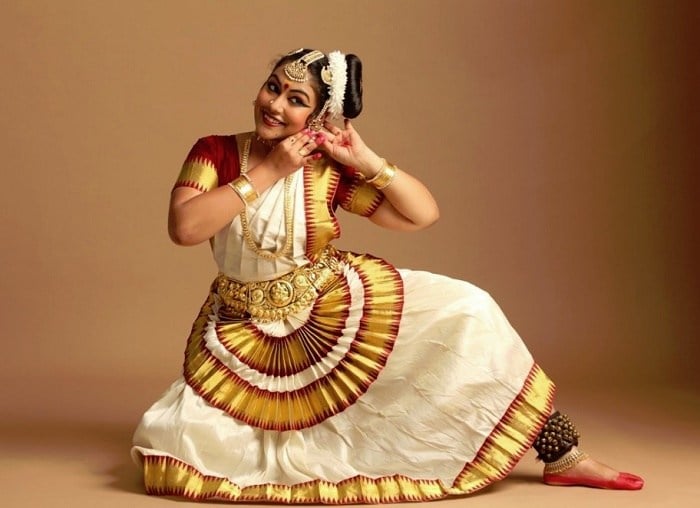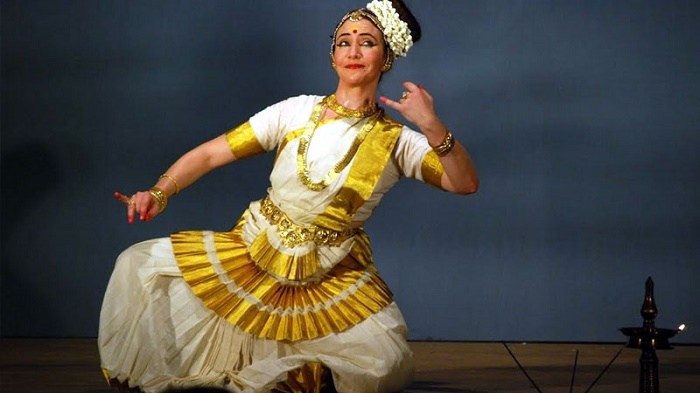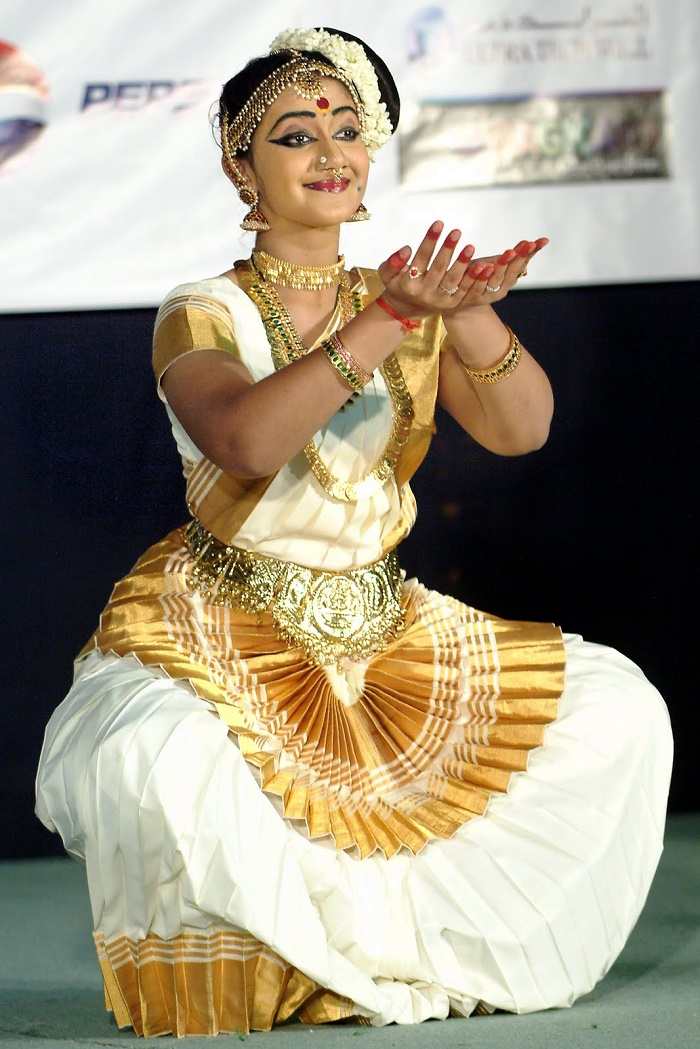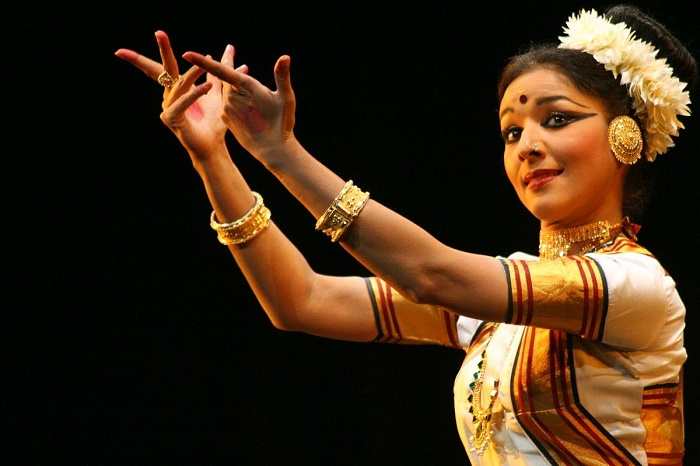
Image Credit: https://urbanasian.files.wordpress.com/2015/06/mohiniyattam1.jpg
Mohiniattam or Mohiniyattam is an Indian classical dance form that evolved in the state of Kerala, India, and is counted among the two popular dance arts of the state, the other being Kathakali. Although its roots date back to the age-old Sanskrit Hindu text on performing arts called ‘Natya Shastra’, similar to other Indian classical dance forms, Mohiniattam adheres to the Lasya type that showcases a more graceful, gentle and feminine form of dancing. Mohiniattam derives its name from the word ‘Mohini’, a female avatar of Lord Vishnu. Conventionally a solo dance performed by female artists, it emotes a play through dancing and singing where the song is customarily in Manipravala which is a mix of Sanskrit and Malayalam language and the recitation may be either performed by the dancer herself or by a vocalist with the music style being Carnatic.
History & Evolution
The theoretical foundation of this dance form like other major classical dance forms of India has its roots in sage Bharata Muni’s text called ‘Natya Shastra’, a Sanskrit Hindu text that deals with performing arts. The first complete version of ‘Natya Shastra’ is considered by some sources to have been completed between 200 BCE to 200 CE while some others mention the timeframe between 500 BCE and 500 CE. It breaks dance into two specific types, the first one being ‘nritta’ or pure dance that centres around finesse of hand movements and gestures, and the other being ‘nritya’ that features the expressive aspect of dance. ‘Natya Shastra’ elucidates several theories of Indian classical dances including on standing postures, basic steps, bhava, rasa, methods of acting and gestures as also two forms of dance – the Tandava dance of Lord Shiva that exhibits more vigour and vitality and the Lasya dance that is more delicate and graceful. The Lasya dance theme and structure is followed in Mohiniattam.
Mohiniattam evolved from the state of Kerala which also has an association with the old tradition of Lasya style of dancing. The temple sculptures of the state are the earliest manifestations of Mohiniattam or other dance forms similar to it. Mohiniattam poses are also palpable from the various feminine sculptures that adorn the 11th century Vishnu temple at Trikodithanam, and the Kidangur Subramanya temple. The Lasya theme was incorporated by Malayalam bards and playwrights, a fact evident from the text-based records starting from the 12th century. The 16th century book titled ‘Vyavaharamala’ written by scholar, poet, author and astrologer Mazhamangalam Narayanan Namboodiri is the first known book that mentions the term Mohiniyattam in connection with a payment due to a Mohiniyattam dancer. While discussing about various performing art forms of Kerala, renowned poet Kunchan Nambiar in his 17th century book ‘Gosha Yatra’ mentioned about Mohiniyattam. By that time this dance form had emerged as one of the classical art forms of the state. The 18th century Sanskrit treatise ‘Balarama Bharatam’ on natyam written by the king of Travancore Karthika Thirunal Bala Rama Varma (considered to be a significant secondary work on ‘Natya Shastra’) refers about ‘Mohino Natana’ among various other dance styles.
Mohiniattam developed further as a performing art during the 18th and 19th centuries, thanks to the patronage of several princely states. The initiation and patronage of the Maharaja of the Kingdom of Travancore, Swathi Thirunal Rama Varma, a poet and brilliant music composer himself, in the early 19th century saw development of a joint team of artists of two genres namely Bharatanatyam and Mohiniattam. His contributions in the art form saw the eventual development and systematization of present day Mohiniattam.

Image Credit: blessingsonthenet.com
Decline during Colonial Rule
As British colonial rule spread in the 19th century, various classical dance forms were subjected to contemptuous fun and discouragement thus witnessing their decline. Eventually social and economic conditions associated with Devadasis of South India and nautch girls of North India added with contempt and despicable attitude from the Christian missionaries and British officials, who held them as harlots, disgraced such systems. Furthermore, the Christian missionaries launched anti-dance movement in 1892 to stop such practice. The book ‘The Wrongs of Indian Womanhood’ by Marcus B. Fuller published in 1900 caricatured the facial expressions and sensuous gestures emoted during temples dances. Such upheaval stigmatized all Indian classical dance forms including Mohiniattam that saw its decline in the princely states of Cochin and Travancore.
Dr. Justine Lemos, who did an elaborate research on Mohiniattam, mentioned that the Maharaja had to ban the dance form under compulsion from the colonial rule and his citizens. However historical evidence does not give indication of any ban on the dance form by enforcement of any law or any public announcement. It also does not indicate that Mohiniattam dancers were temple harlots or devadasis. Nevertheless Lemos mentions of evidences that point out that scholarship, rewards and payments were made to Mohiniattam dancers. She also mentions of laws enforced during 1931-38, which although do not mention Mohiniattam, banned temple dancing, devadasis and all forms of "lewd dance or theatre" as long as the princely states of Kerala were under the rule of the British. The ban was rescinded partly in 1940 that permitted performance of "voluntary dances in temples". A new law enforced in the following year made clear that voluntary dances were allowed however without any pay. Mohiniattam artists demanded that they should receive payment from the state or by the viewers, but were not paid by the state.

Revival
In the midst of such disturbances some female artists continued to perform this art in Hindu temples without paying heed to the political developments surrounding the art form. With the progress of the Indian freedom movement the early 20th century, efforts among Indians were being made to revive national culture and tradition and rediscover the rich history of India in order to resurrect the very essence of the nation. Many classical art revivalists questioned against such discrimination and came forward in reviving the ancient classical dance forms. Among them, Vallathol Narayana Menon, a Malayalam language poet who was counted among the triumvirate poets of modern Malayalam, not only aided in rescinding the ban on temple dancing in Kerala but also revived and reconstructed the dance form. He established a dance school called ‘Kerala Kalamandalam’ in 1930. The very inception of Kalamandalam helped revive Mohiniattam, Kudiyattam and Kathakali, the three main performing arts of Kerala. He also inspired many to learn and practice Mohiniattam.
Repertoire
Traditionally the repertoire of Mohiniyattam follows two performance categories namely, ‘Nritta’ and ‘Nritya’ mentioned in ‘Natya Shastra’. It follows the Lasya type of dance that showcases a more graceful, gentle and feminine form of dancing and displays excellence in ‘Ekaharya Abhinaya’ form in other words a solo and expressive dance art complimented with music and songs. ‘Nritta’ is a technical performance where the dancer presents pure dance movements giving stress on speed, form, pattern, range and rhythmic aspects without any form of enactment or interpretive aspects. In ‘Nritya’ the dancer-actor communicates a story, spiritual themes through expressive gestures and slower body movements harmonised with musical notes thus engrossing the audience with the emotions and themes of the act. ‘Natyam’ is usually performed by a group communicating a play through dance-acting. Mohiniyattam’s repertoire sequence includes an invocation or Cholkettu, Jatisvaram, Varnam, Padam, Tillana, Shlokam and Saptam.

Costumes
The dancer wears a white or off-white plain sari embellished with bright golden or gold laced coloured brocade embroidered in its borders complimented with a matching choli or blouse. A pleated cloth having concentric golden or saffron coloured bands adorns the front part of the sari from the waist. This embellishment not only lets the artist perform her spectacular footwork flexibly but also highlights it, allowing the audience to watch it from a distance. She also wears a golden belt around her waist. Jewellery adorns her head, hair, ears, neck, wrists and fingers. Musical anklets called ghunghru made of leather straps with small metallic bells attached to it are wrapped in her ankles. These produce rhythmic sound while she showcases excellent footwork. Her feet and fingers are brightened with red coloured natural dyes so as to highlight gestures of her hands. Face make-up of the dancer is usually light with a Hindu tikka on her forehead while her lips are vividly coloured red and her eyes are lined prominently so as to make her eye movements more visible. Her hair tied typically on left side of her head is in tight round chignon hairstyle and beautified with flowers, usually jasmine, ringed around the bun.
Instruments & Music
Vocal music of this performance art incorporates different rhythms and lyrics of many of the compositions performed in this dance form are in Manipravala that is a mix of Sanskrit and Malayalam language while the music style is Carnatic. Instruments played during a Mohiniattam performances usually comprise of Kuzhitalam or cymbals; Veena; Idakka, an hourglass-shaped drum; Mridangam, a barrel-shaped drum with two heads; and flute.
Famous Exponents
Imminent 20th century exponents of Mohiniattam apart from Vallathol Narayana Menon were Kalamandalam Kalyanikutty Amma, Thankamony, Krishna Panicker and Mukundraja. Present day exponents include Sunanda Nair; Smitha Rajan, granddaughter of Kalyanikutty Amma; Radha Dutta; Vijayalakshmi; Gopika Varma and Jayaprabha Menon among others.



